 Total Systems Development, 2019
https://leancpi.com/wp-content/uploads/2019/12/HR-Gold-Standard-Roadmap.jpg
720
1280
John Allen
https://leancpi.com///wp-content/uploads/2017/04/TSD_Logo2.png
John Allen2019-12-02 13:07:062022-04-05 08:41:43Introduction to the HR Gold Standard Roadmap
Total Systems Development, 2019
https://leancpi.com/wp-content/uploads/2019/12/HR-Gold-Standard-Roadmap.jpg
720
1280
John Allen
https://leancpi.com///wp-content/uploads/2017/04/TSD_Logo2.png
John Allen2019-12-02 13:07:062022-04-05 08:41:43Introduction to the HR Gold Standard RoadmapLean HR
Human Resources was primarily put in place to ensure that the value add is delivered. Its main function is to create a system that allows value to flow smoothly and evenly without interference. They focus on the key areas of pay, benefits, employee relations, safety and development as the areas that have the most influence with the people who add value. Lean HR also places the same level of commitment to those who support the people who add value. In this way, the emphasis is to enhance the process of delivering value through the direct engagement of each group with the aim of enhancing business performance.
Mind Map Introduction:
Creating something out of nothing is far easier than getting an established system to change. Our Lean HR mind maps were brought to life as an attempt to help those motivated to take on change in the people system. We have found that just any change or two is not sufficient. If we are to succeed, then we must make changes that enhance the whole. This is a systems change. And it is a challenging test at best.
(What’s a mind map?)
The nature of the test is to ensure that all changes support the intent of the organization as put down by the mission or operating principle. Each and every change must be another piece towards realization of the system vision.
The mind maps below are our experience brought to order piece by piece. They are incomplete but a step towards a complete description. Start with one piece and bring it to life. This will uncover all that needs to be done. It is entrusted to you with the hope that we can all improve. Continuous improvement through small changes is the best. This document is ours together.
Mind Map Updates:
Lean HR System
Personnel
Employee Relations
Administration
Training & Development
Coming Soon: Health & Safety
Coming Soon: HR Research & Development
Interested in John Allen’s Lean HR eBook?
Register here for a FREE download
Lean HR System Mind Map
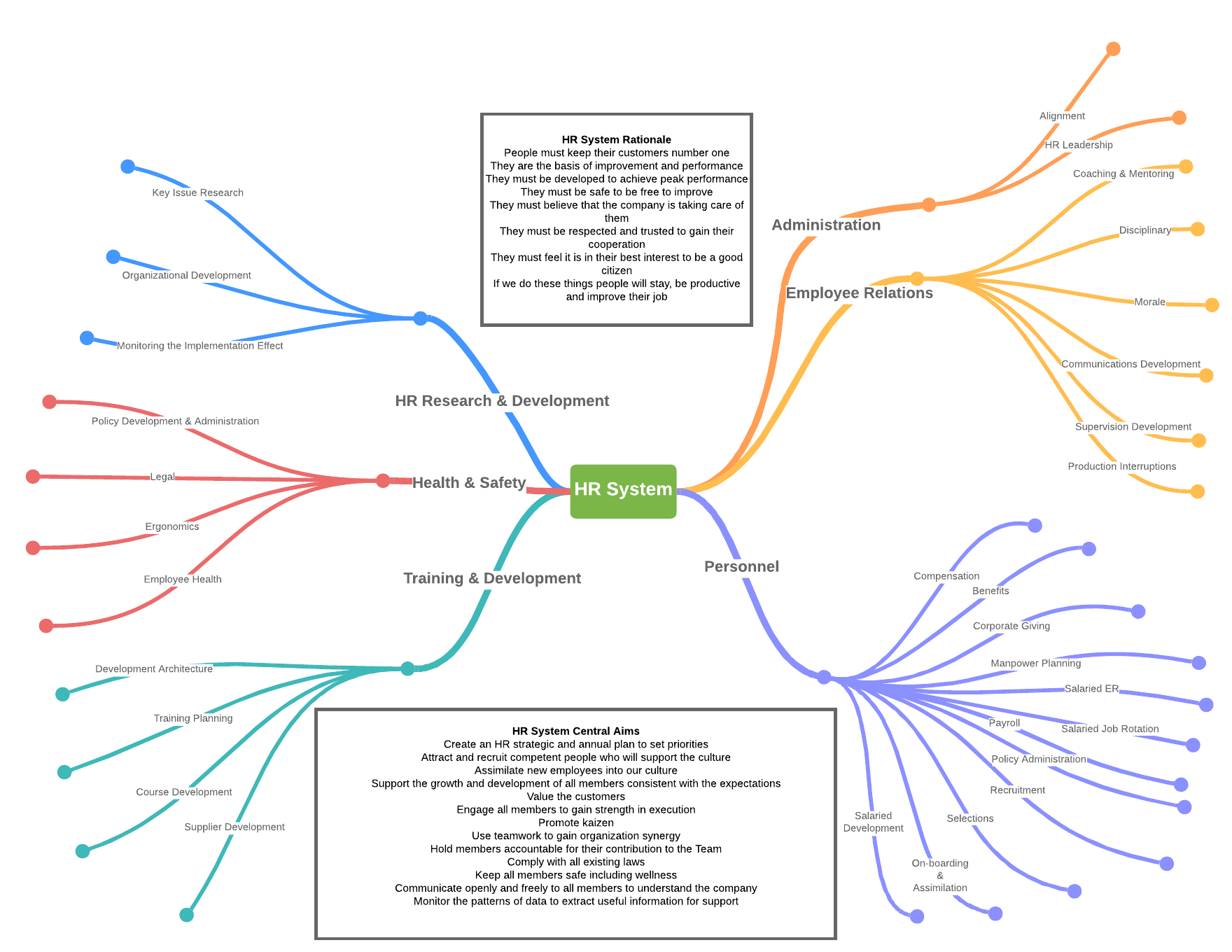
Personnel
Basics: A part of the HR Department that is focused on recruitment, compensation and benefits, and salaried employee relations. Will develop policy and plans for the creation and development of the elements of its role. Must coordinate with the rest of HR, management and employment relations.
Why Important to CPI?: Part of the system of work and must align with the values and operating principles of the organization. Must align with the rest of HR.
Connections (Ops, other HR, PC etc): Connects in the resolution of problems, delivery of competency to the organization, meets cost constraints, creation of positive relations from compensation and benefits. Ensures the administration of pay and benefits is smooth and fully complete. Develops the manpower plan and coordinates with all organizational units.
Employee Relations
Basics: In an organizational setting it is a mandate for all to achieve the very best employees can demonstrate. To achieve this the organization must create an environment that reflects the value of all employees. To this end ER is established to find and solve “people” problems and develop the organization to maintain the standard of relationships through mutual trust and respect and creating a homelike atmosphere. To demonstrate gratefulness in all transactions. Promotes teamwork.
Why Important to CPI?: To maintain and improve the standard of operation. You can not have improvement if you can not demonstrate the basis of comparison to measure against the improved state. Must be practical to the entire workforce by creating awareness of solving problems at the level of the team member.
Connections (Ops, other HR, PC, etc): This requires close coordination of all aspects of the organization. Value adder perform to the operations standards and improve then through continuous reflections. All other support the value adders in the performance of their work.
Administration
Basics: The backbone of the Employee Relations organization is the capacity to collect and define data involving team members. It reputation is based on delivering analysis, processing the administration process and fairness in all interactions. The aim of administration is to maintain a seamless process that delivers reliable and empirically perfect products.
Why Important to CPI?: It must follow the same process standards that require the pathway and outcomes leading to a zero was process. This is seldom seen but must make administrative processes trustworthy for all team members
Connections (Ops, other HR, PC, etc): Data and processes flow from the entire organization. Analysis such as manpower planning are critical to the management of the cost of manpower and benefits.
Training & Development
Basics: Training and development is a business strategy for keeping the knowledge base strong, developing individual is the appropriate behavior on the job and preparing individuals for promotion and job rotation assignments. Training is based on development of competency and development is mostly the role of the supervisor. Together they form a strong component for a learning organization. For the value adders and most support personnel the basis of their training and development is standard work. It contains the best way known by the individual to pass to others as they learn new jobs. It is also the place where improvements are added to existing standard work to make sure improvements are not lost but are sustained until the next improvement takes place. Problem solving and strengthening the standard for sustainment is the role of the person doing the standard. This piece not only helps sustain the standard but develops with practical experience the competency of the person.
Why Important to CPI?: The two basic responsibilities of a member is to perform their standard work and to improve it. Development is the key to these. The member needs to be able to understand the overall strategy and goals in all its implications for their role. To understand, their leader must accept the responsibility of putting these into language that will communicate this to them. The leaders must be able to perform their competencies in an ever-changing environment and accomplish their role of managing the performance of adding value and of development of their subordinates. Everybody gets developed not as an aspirational goal but as part of the business plan, even the suppliers.
Connections (Ops, other HR, PC, etc): Impacts and is extended to all parts of the organization.
Coming Soon!
Coming Soon!
Lean HR System: Personnel Mind Map
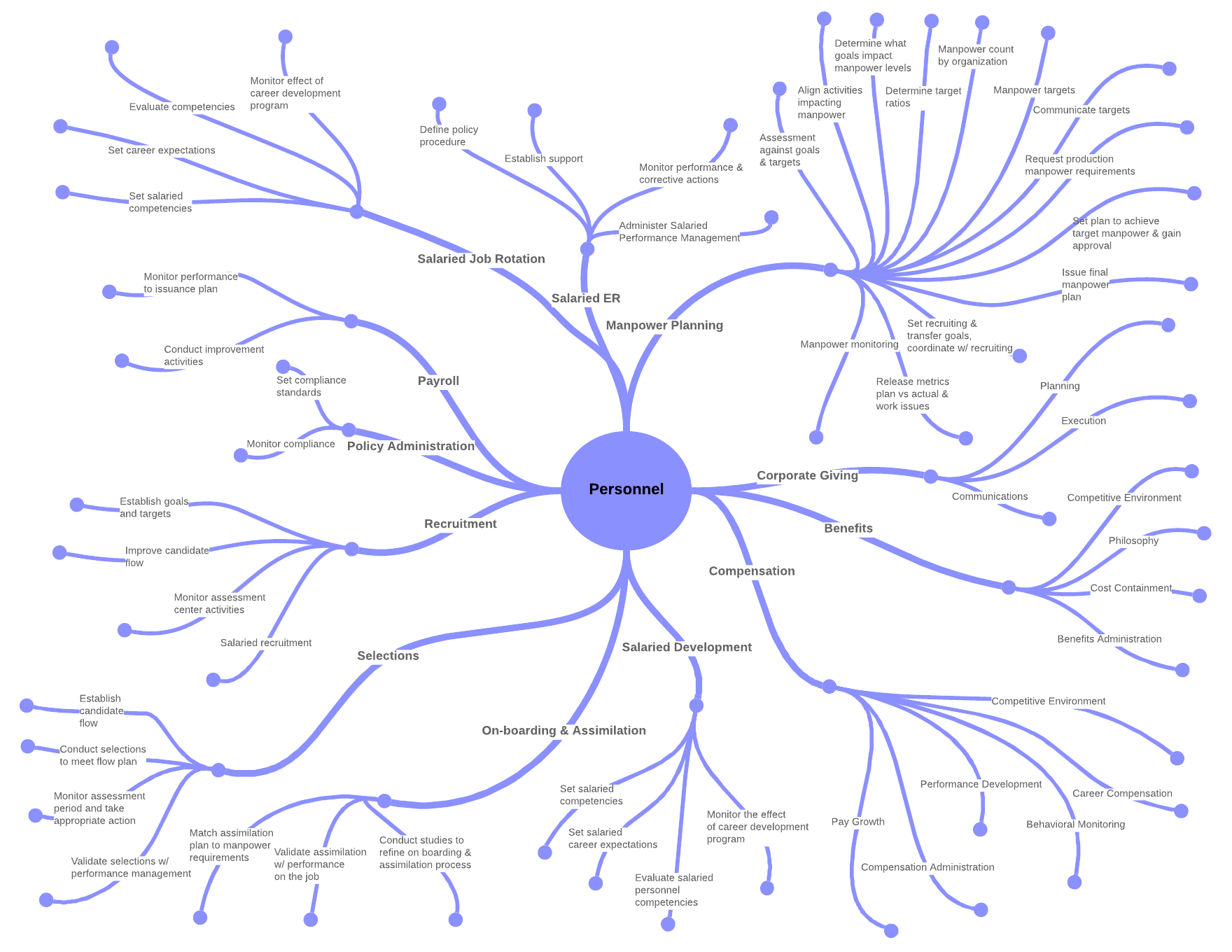
Compensation
Basics: It defines competitive pay rates and ranges. Defines the approach to pay advancement. Define the elements of pay and how administered. Defines pay ranges for all salaried classifications. Analyzes pay issues to determine the best way forward. Defines pay ranges and rates of pay considering performance levels and years in the company.
Why Important to CPI?: Must create a smooth and easily understood process to pay. Must work individual issues in the context of the organization’s goals and mission. It must be fair in its administration and analysis of competitive rates.
Connections (Ops, other HR, PC etc): Must be connected to all of the organizations to understand the effects of compensation on morale and career.
Salaried Development
Basics:Every member has a clear expectation of sustaining success over the life of their career. Basic competencies are learned at the lowest level of the organization. As they progress, the expectation is that they are developed at a predictable rate. At each level of progression, the competencies are defined and the development process to achieve them are defined. Some competencies are learned on the job, some in the classroom and some are encouraged to be learned outside of work. The plan is aimed to extend over the entire career for an individual and is supplemented by job rotation. The achievement of competency is a significant portion of the performance evaluation. Each members leader is responsible to see the development is accomplished mostly through problem-solving opportunities.
Why Important to CPI?: Growth in salaried team member competencies is a vital component to achieving the organization’s strategy.
Connections (Ops, other HR, PC etc): Every member is expected to develop for their entire career. Development can come from many sources and is defined and maintained in the individual performance file. The development must be linked to the Hoshin for the department in which they work as well as other departments that require support.
Onboarding & Assimilation
Basics: They ensure that every person brought into the organization is competent to work in the environment they are assigned. Assimilation is the intent to ensure the individual has the greatest opportunity to be part of the success of the organization. They ensure that everyone has an equal opportunity for success. Creates a basic level of understanding of how work is performed and how it is improved. Conditioned individuals for the demands of the job. Ensures that job instruction is properly used to instruct a person in a new job during the orientation period.
Why Important to CPI?: It sets clear expectations. Allow the member to clearly understand the expectations of a job. Places the clear emphasis on first learning to achieve quality in their job and later after sustainment, to improve the job.
Connections (Ops, other HR, PC, etc): Connects to all parts of the organization.
Selections
Basics: All selections are based on the level of competency the individual can demonstrate. Various methods are used to determine the level of competency for the individual. Simulations, group interactions and workplace working at pace on assembly tasks. In addition, the input from the performance appraisals is used for promotion selection. Assignments for job rotation are determined by development needs.
Why Important to CPI?: Keeping the employees open to learning and flexible to new situations. It allows the members to see a variety of problems and issues and demonstrate how they can support improvement.
Connections (Ops, other HR, PC, etc): Part of selection is organization-wide. Does the planning for job rotation. Manage the performance appraisals for all salaried personnel. Responsible for bringing new salaried personnel into the organization. Must coordinate with all departments for selection timing and individual requirements. Responsible to coordinate salaried manpower planning.
Recruitment
Basics: Define the organizational requirements for skills and behaviors. Define the process to recruit and select an individual to come into the organization, requirements for performance expectations, requirements for promotion, transfer and job rotations. Defines a process for bringing individuals into the organization and achieve success on the job, defines processes for performance management and defines recruitment pools to be maintained. They ensure that selections are based on competency, not race, color, sex, religion, creed, national origin, age, disability, or genetic information.
Why Important to CPI?: They bring in competent members, define how they move in the organization and set expectations for performance. They develop recruiting sources and manage the flow of individuals for selection. They validate selection processes.
Connections (Ops, other HR, PC, etc): They connect to every level and every individual in the organization.
Policy Administration
Basics: Write and interpret the policy to resolve issues or problems. Works directly with the ER Representative to create success in every situation possible. Communicates policy to the entire organization changes policies as is dictated by leadership. Makes sure all policies are rationalized to the value adder.
Why Important to CPI?: Designed to create success and individual accountability. It impacts how members are encouraged to improve. Impacts the emphasis on continuous improvement.
Connections (Ops, other HR, PC, etc): Connects to every part of the organization. Some policies may be specific to individual groups but most cover all groups.
Payroll
Basics: Responsible for delivering an accurate payroll for every pay period. Expected to improve their process. Must be able to deal with all organizational elements to set clear expectations for timeliness and accuracy of input hours and rates. Must be able to quickly reconcile the payroll of individual mistakes or exception to correct the information and deliver a new amount.
Why Important to CPI?: They have a view of the effective implementation of hours of work and are expected to improve processes and reaction time to new data.
Connections (Ops, other HR, PC, etc): If they do both salaried and hourly payroll they are connected to the entire organization for new rates and schedules resulting from promotions, transfers and pay improvements.
Salaried Job Rotation
Basics: In the Toyota organization, good thinking is not just limited to the direct responsibility of the individual. Value to the organization can be achieved by broadening responsibilities. One process of broadening is to rotated individuals into different departments, or organizational units to learn how the basic philosophy is consistent, how the process orientation is the same and to learn the technical aspects of a new job. Some technical areas require that those coming in have a satisfactory level of technical expertise and therefore, those eligible must be able to understand and execute specific technologies.
Why Important to CPI?: With a wide knowledge of various parts of the organization, the individual is more able to see possibilities and solve problems.
Connections (Ops, other HR, PC, etc): Everyone brings a process orientation to any new job. Some bring specific skills (engineering) and each is expected to operate in their new environment understanding and improving process. New technical processes are learned and accompany the individual throughout their career. A basic set of behavioral expectations will accompany an individual rotating. All have operated under the same set of policies.
Salaried ER
Basics: Employee relations is an issue for both salaried and not-salaried personnel. For salaried, the issues may vary from an emphasis on the differing expectations. It is an internal decision to decide if the separation of the two is important.
Why Important to CPI?: Continuous improvement is an issue for attainment by salaried personnel. In a continuous improvement organization, the additional expectation is for support for the value adders. It is key that they do not show up at a workplace with the answers but with process suggestions and maybe some hints to energize the value adders.
Connections (Ops, other HR, PC, etc): The connections come from several important aspects of salaried work. First, they must make sure that what they move forward like, design, initiative or goals are rationalize with the members doing value adding. Secondly, they can be vital to initiate improvement or to extend their efforts into the value adding. Thirdly, it is a support effort mostly and must show up with legitimate ways to support value adding.
Manpower Planning
Basics: Manpower planning is the process of estimating the optimum number of people required for completing a business plan, true capacity, project, task or a goal within time. It is a never-ending continuous process to make sure that the business has the optimized resources available when required taking into consideration the upcoming future events and also the replacement of the outgoing employees.
Why Important to CPI?: To answer the question of the elimination of waste, in overburden, under-utilization and expanding the pace of business.
Connections (Ops, other HR, PC, etc): It is an organization-wide effort to have a complete picture. Can affect the ability to get the work done, the ability to promote from within and the basic ability to complete customer expectations.
Corporate Giving
Basics: Corporate giving is an indicator of how the organization sees the issues in the external environment. These issues are an indication of affiliation. Choosing the wrong affiliation and the employees may question the ulterior motive. These decisions should be made in a transparent way to avoid suspicion.
Why Important to CPI?: It is a basic trust issue.
Connections (Ops, other HR, PC, etc): It is an organization-wide decision and should be analyzed based on the rationale and the effect on the organizational population.
Benefits
Basics: Benefits are part of total compensation. It must be understood as a part of a persons pay & be considered something competitive.
Why Important to CPI?: The significance is in the earning of benefits based on performance. Nothing is free and must be understood as a part of pay. Will be viewed as part of the long term commitment of the organization. Analyzing just as part of the compensation will place the significance of them as part of total comp and a clear sign of the companies willingness to keep their employees protected and compensated.
Connections (Ops, other HR, PC, etc): The connections are to every part of the organization. The distinction of being part of one level of the organization and another will be judged by the team members as a sign of equity from the leadership. When looking at the specific classification that may be hard to recruit without a distinctive pay and benefits plan, the issue for the organization is to be careful to review the situation every planning period as scarcity changes over time. When compensation reflects scarcity, fairness becomes an issue if other scarce resources are not seen as such. Equity is a key determinate of leadership trust.
Lean HR System: Employee Relations Mind Map
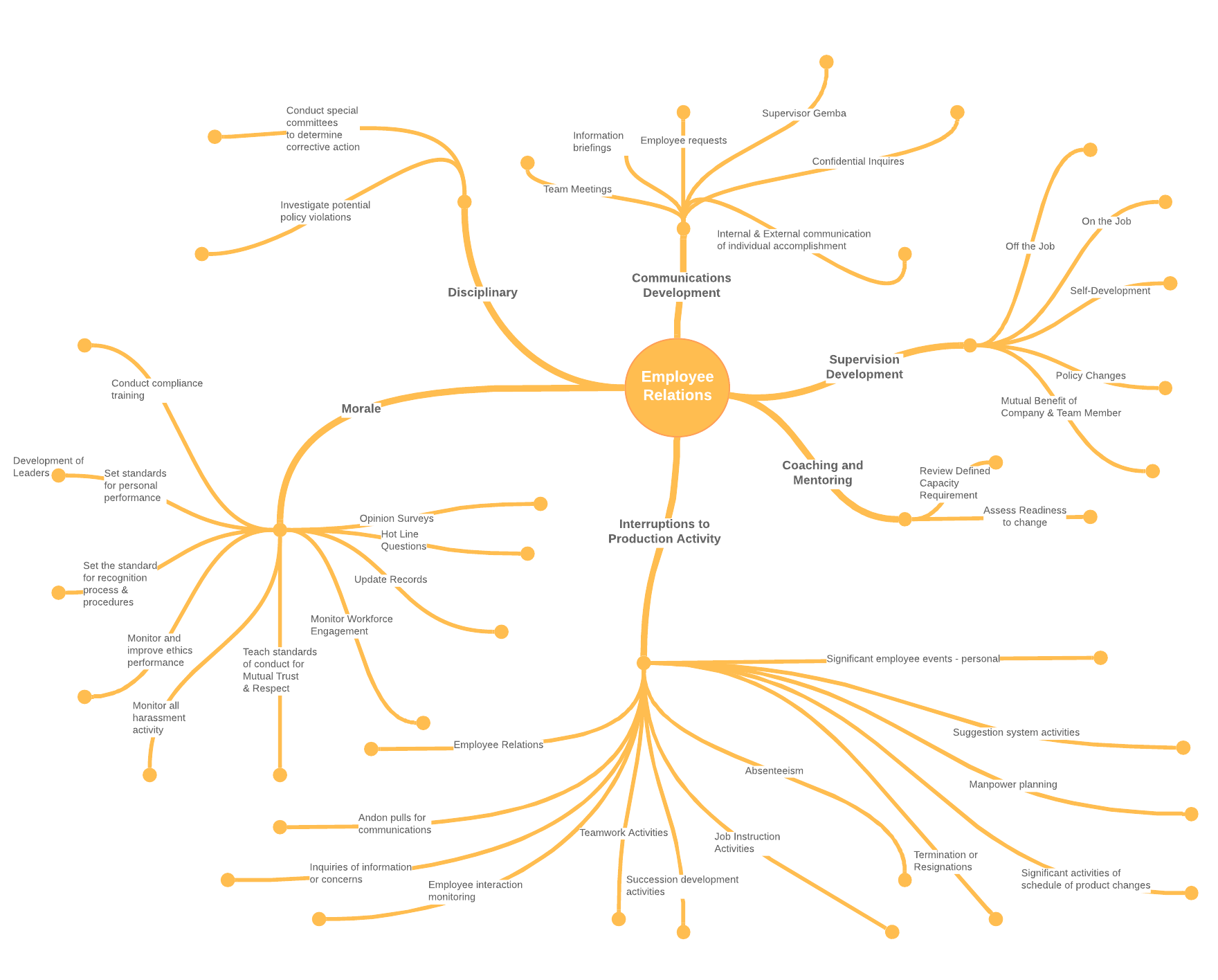
Interruptions to Production Activity
Basics: The ideal lean line is set up to both pace the production and to “lift up” deviations from the plan including standard work that can not be completed. The support for this condition of flow is support in two important ways. The first is that there is an organization set up call Production Control that monitors the line output to determine if overtime is required, if the daily schedule is achieved and the line shut down. The Andon is a tool used to signal when a production operator is having a problem. The operator is taught, if they cannot achieve their standard work for any reason, they must pull the cord and let the Team Leader must respond immediately. As the system indicates this cycle is an opportunity for many types of responses and it is ER’s responsibility to monitor and assure all reactions are consistent with mutual trust and respect. Problems are seen as opportunities for the individual to achieve creativity.
Why Important to CPI?: To maintain positive relationships with the employees while assurances of maintaining production or product flow consistent with the least amount of waste.
Connections (Ops, other HR, PC, etc): These real situations are the result of several critical organizations each with a specific component of production: Production Engineering- support the problem solving process; Production Control- delivering what is need on the line to meet standard work, defining daily schedule, monitoring the line and providing project management to the line for major projects; Supervision- making sure the line is prepared to solve problems, operators are prepared to solve problems, and monitoring the relationship to achieve the Organization’s objectives; ER Representatives- monitor,coach and support the operator to achieve standard work, defining people system deviations, plans and delivers the communications plan and monitors the accountability in the Corrective Action Policy.
Morale
Basics: Morale is a constantly developing aspect of an organization who values continuous improvement and job satisfaction. It must be monitored to ensure the enactment of mutual trust and respect. It takes courage on the part of the supervisor to allow the development of the individual while attaining mutual trust and respect. Morale is measured on a frequency consistent with maintaining improvement of morale. It is also monitored through micro measures continually such as attendance, percentage of participation in CPI in a team, number of “hotline calls” divided by issue, general complaints or grievances and daily reports from the ER Representatives.
Why Important to CPI?: It is a foundational element of an organization for continuous improvement to feel the need and value of improvement. Includes performance evaluation, career paths and development.
Connections (Ops, other HR, PC, etc): Morale is an organizational wide issue aggregated by ER to understand trends and emerging issues. This issue of fairness, openness, and acceptance is sought throughout the organization.
Disciplinary
Basics: Discipline is based on personal accountability and a commitment to achievement. Any problem with performance or relationships can only be resolved with personal accountability from the employee who has a problem unique to them.
Why Important to CPI?: To create a harmonious organization. Resolving disciplinary issues and emphasizing the opportunity for growth to those overcoming issues.
Connections (Ops, other HR, PC, etc): ER must initially lead the effort to embed personal accountability until the line organization can reflect the purpose and process for developing an individual with an issue leading to corrective action.
Communications Development
Basics: Open communications to and from the organization is essential to achieving perspective by individuals within. It allows both sides of any story to be heard. It allows the person to maintain focus on adding value. This creates thoughtful leadership as they strive to communicate effectively.
Why Important to CPI?: To maintain the standard and feel the accountability to solve problems and make improvements.
Connections (Ops, other HR, PC, etc): ER is responsible for the outflowing communication and to create the trust and value in the information that flow to them. All other organizations must reflect the information flowing out from the organization to create the reliability of the messages.
Supervision Development
Basics: First is the selection of competent leaders. ER must authenticate the selection process and suggest improvements. ER and the normal organizational structure is responsible for developing supervisors who live the values and operating principles. Supervisory development is a clear number one priority for all of supervision. The developmental process must be planned and cover issues resolved to accommodate the schedule. Each supervisor is taught how to develop individuals through delegation.
Why Important to CPI?: The supervisor is directly responsible for delivering all aspects of the values and operating principles especially when change is required. Their development will cause the values and operating principles to be an environment that is predictable and reliable for all the employees.
Connections (Ops, other HR, PC, etc): There are three major connections for the supervisory development. First the leader who has supervisors under their leadership; Secondly, the Training Department who defines the competencies, create the development engagements and assesses the value derived from the training; and finally the ER Representative who observes and coach the supervisors while assessing the needs and realization of training and development.
Coaching and Mentoring
Basics: Relationships take on many forms. Coaching is a direct engagement with the employee aimed at improvement. Mentoring is an indirect relationship that is based on the development of an individual. It is characterized by having a relationship first and development based on mutual trust. Must maintain a long range perspective to eliminate surprises to the team member and coach all leaders to define longer term solutions. Works faithfully to go see problems and define the real situation.
Why Important to CPI?: Both are important for the development of the people in the organization. Each has a different role. In the end the success of either is based on mutual trust and respect. It promotes organizational learning and consensus building.
Connections (Ops, other HR, PC, etc): The process of considering from the facts requires facts to connect all organizations a natural part of relationships.
Lean HR System: Administration Mind Map
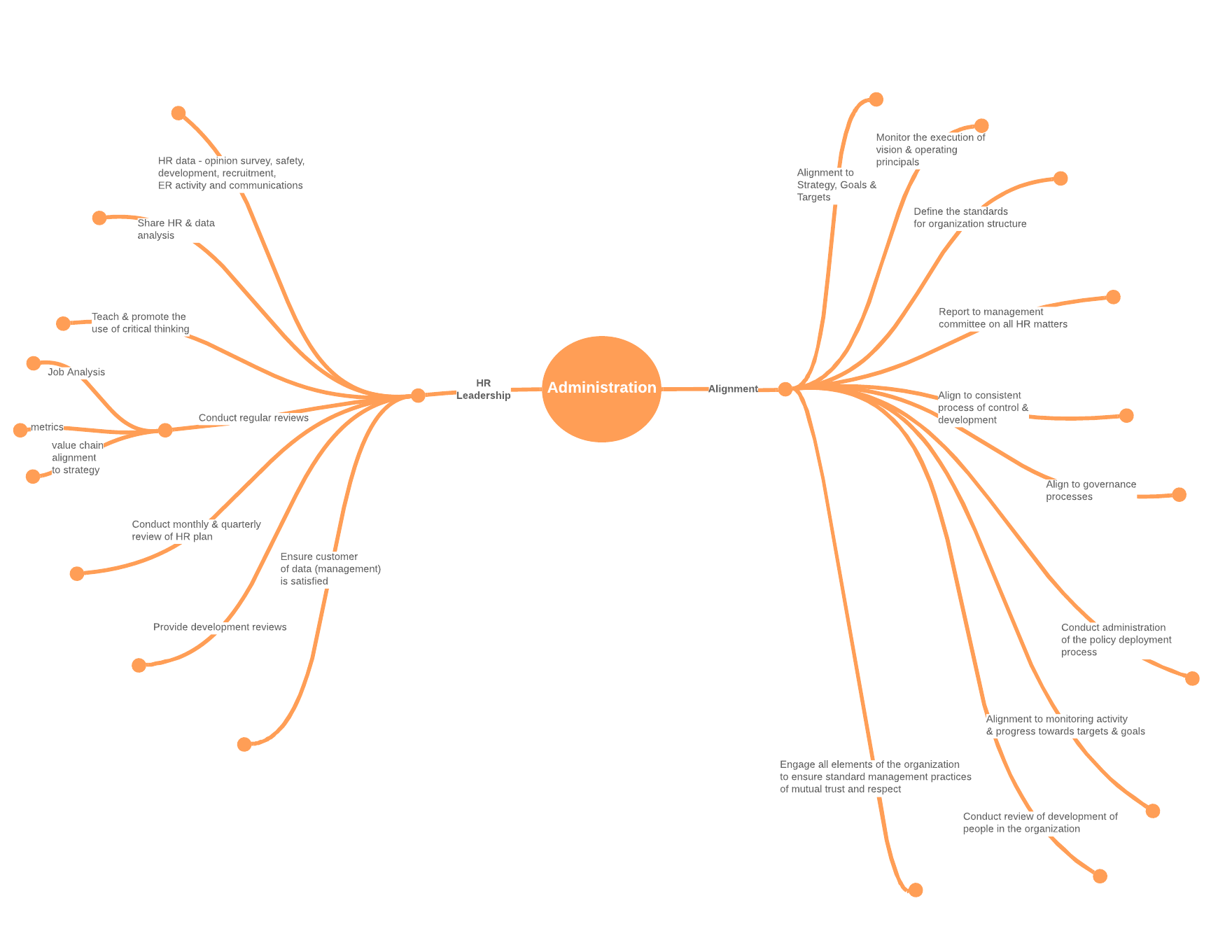
Alignment
Basics: Every year the goals of the organization are created at the highest level and deployed to every level. This process requires alignment and commitment to be achieved.
Why Important to CPI?: The resulting annual goals are monitored closely, problems are identified and solved, and quarterly organization wide reviews are conducted. These goals represent the portion of the goals to be achieved to bring improvement to the entire organization. The key is that all members who are required, even across organizational boundaries, are required to provide commitment to those goals. This process sends a clear message about the importance of improvement. ER coaches the supervisors and managers in the process of achieving alignment and commitment.
Connections (Ops, other HR, PC, etc): Involves everyone in the organization to understand and demonstrate their commitment by producing their plan to support the leaders goals.
HR Leadership
Basics: All leadership inclusive of HR are required to represent the values and operating principles of the organization in all interactions. In order to accomplish this they need to have timely and accurate information.
Why Important to CPI?: Process improvement comes in small increments. It is important to monitor the trends and events that form the fabric of HR. Administration will have the ability to trace and monitor several moving issues to determine how the shop is performing. It should be able to track issues with the Andon Lines to determine issues that cause the line to stop continuous flow. It should track the administration of job instruction to determine how flexible the lines are in learning new jobs. It should trace attendance, participation in the suggestion system to see how well the supervisor is support it, and should track all corrective action to see if there are any trends that may be impacted by supervisory skills.
Connections (Ops, other HR, PC, etc): Administration should be connected to all organizations. The cumulative effect of the data provides an important source of actions that support or not support the goals and the future of the organization. Any connection and accumulation of data should be shared with all employees in a way to bring success of the overall organization. Individuals should never be singled out for reporting. This is too close to punishment.
Lean HR System: Training & Development
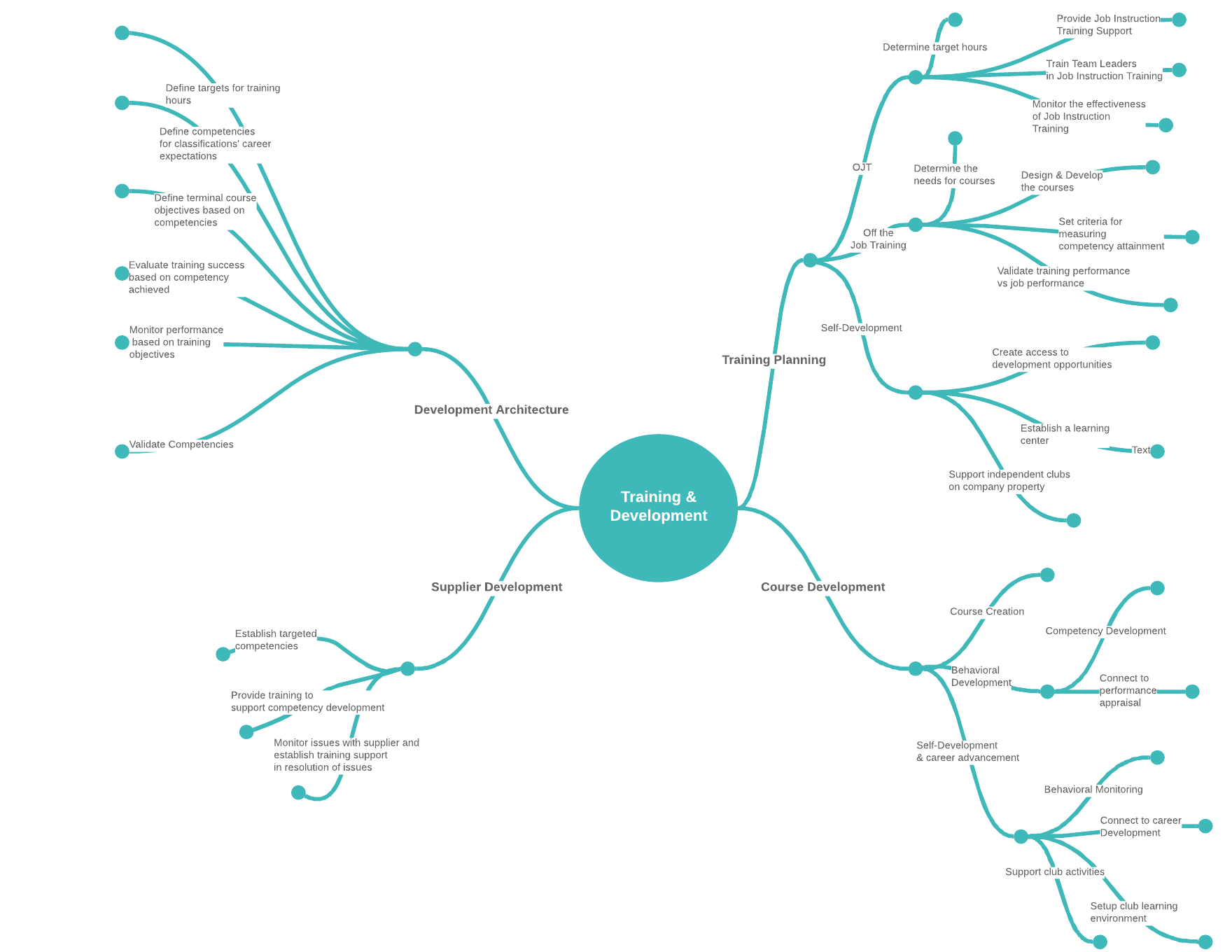
Training Planning
Basics: Training planning involves the development of curriculum to achieve competency improvement continuously over the complete training period. It determines the pace of training fo individuals and the method for getting approval of the Executive Committee to proceed.
Why Important to CPI?: It sets the business priority, the time to be allocated and the expectations for competency improvement. All of these positively impact the creation of value and demonstrates mutual trust and respect to the members.
Connections (Ops, other HR, PC, etc): The training plan involves the entire organization and chosen suppliers.
Course Development
Basics: The process of determining the terminal course objectives and creation of course content and delivery methods to achieve competency development.
Why Important to CPI?: It makes the connection between the behavior expected on the job and the training content.
Connections (Ops, other HR, PC, etc): It involves the entire organization in assessing their development, the leaders in assessing their attainment and usage of competency and the Executive Committee’s realization of the goals.
Supplier Development
Basics: The expectations for suppliers in process, people development and performance are the same as for the company. These expectations drive the development expectations for performance and people relations.
Why Important to CPI?: 50% to 75% of the cost of production comes from external suppliers. Their role is gaining in importance and their development will drive their performance. Additionally, it is a positive relations builder when the company can offer to the suppliers training from their programs.
Connections (Ops, other HR, PC, etc): This connects the main production facility to the suppliers.
Development Architecture
Basics: To accomplish the development of members and leaders they must have a game plan. The architecture is the game plan. It involves defining the competencies, defining how development is going to proceed either through on the job, classroom or personal development. It also includes the process of assessing the attainment of competency and how it effects the performance of the units.
Why Important to CPI?: It is important because it is a key strategy to have people ready to take on the current work environment, any new one defined and be prepared for taking on more responsibility.
Connections (Ops, other HR, PC, etc): Impacts and is extended to all parts of the organization
Please take advantage of these other Lean HR resources from TSD
LinkedIn Articles:
The Role of HR in a Continuous Improvement Organization:
Attitude Towards Problem Solving
Supporting Enlightened Leadership
The Attainment of Job Security
Courage to Fight & Attain HR Excellence
Building Better Work Relations

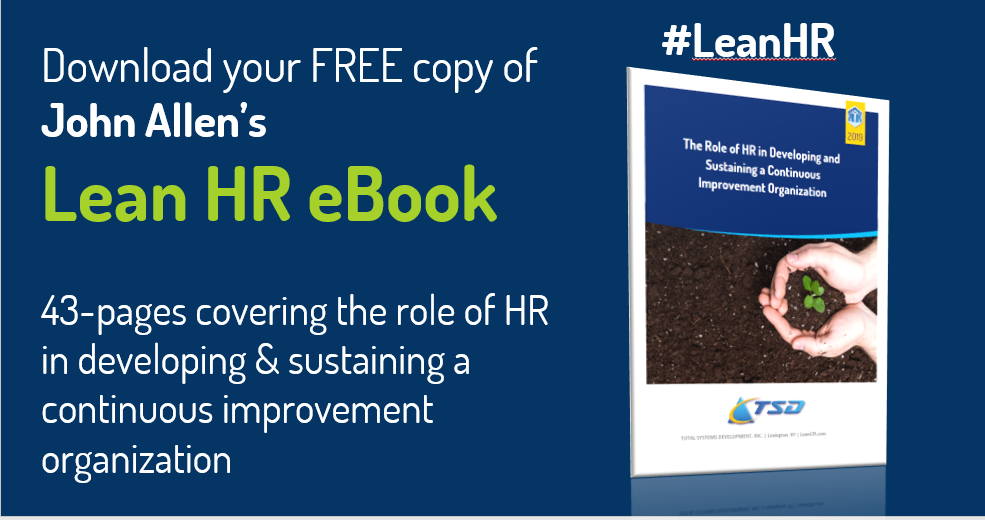
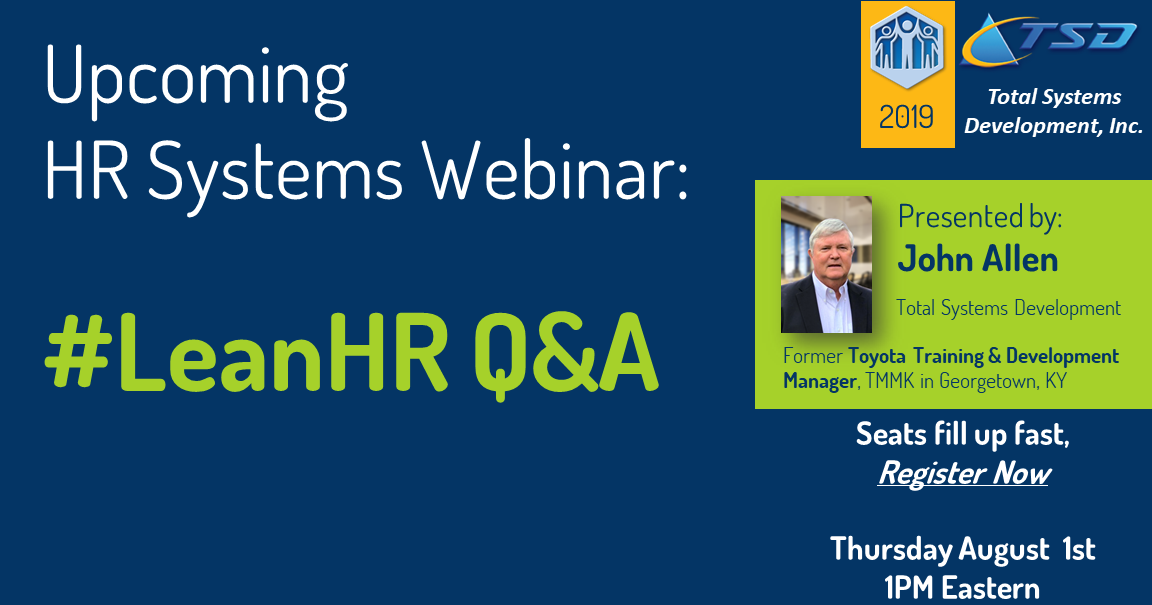

 2019, Total Systems Development, Inc.
2019, Total Systems Development, Inc. 2019, Total Systems Development, Inc.
2019, Total Systems Development, Inc.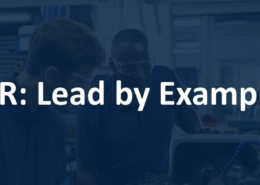 2019, Total Systems Development, Inc.
2019, Total Systems Development, Inc.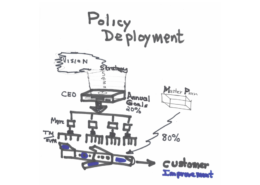 2019, Total Systems Development, Inc.
2019, Total Systems Development, Inc.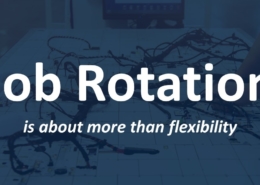 2019, Total Systems Development, Inc.
2019, Total Systems Development, Inc.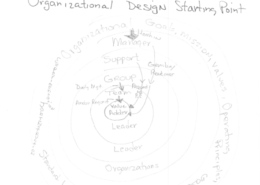 2019, Total Systems Development, Inc.
2019, Total Systems Development, Inc.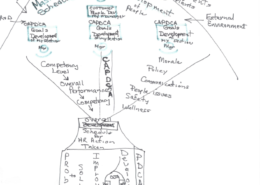 2019, Total Systems Development, Inc.
2019, Total Systems Development, Inc. 2019, Total Systems Development, Inc.
2019, Total Systems Development, Inc.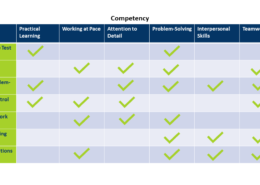 2019, Total Systems Development, Inc.
2019, Total Systems Development, Inc.